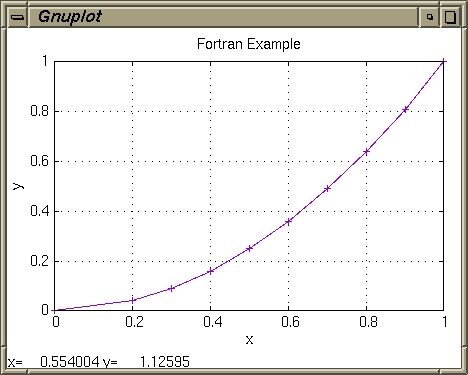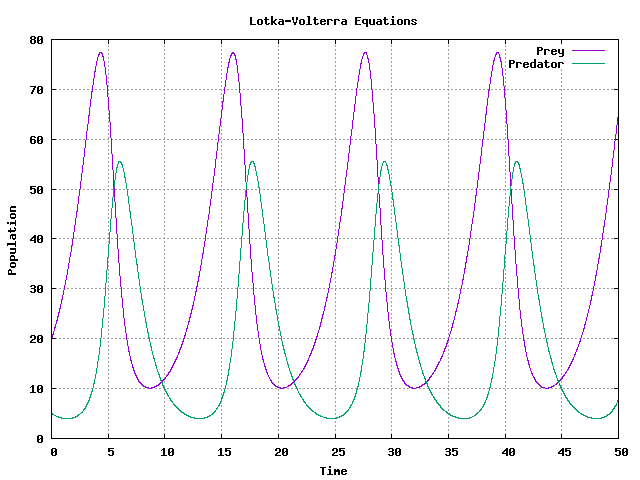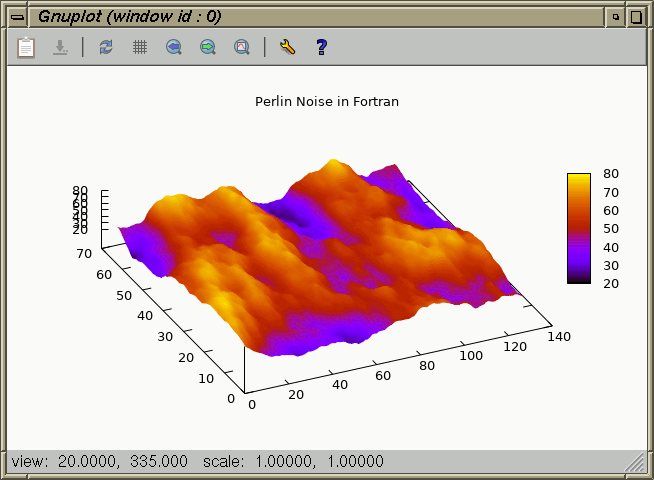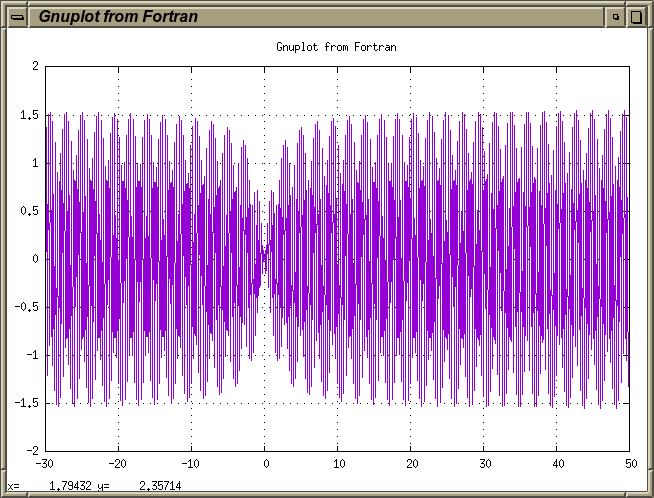Gnuplot
Gnuplot is a free plotting tool that can be run from the command-line or invoked by third-party applications. Despite its name, the program is not related to the GNU project. The plotting commands and the input data are read from files or stdin. The development of Gnuplot started already in 1986.

- Fig. 1: Gnuplot called from Fortran
Plots can either be displayed inside a window (fig. 1) or exported in various image formats:
Command-Line Execution
The Fortran example below writes the output data to a text file
data.txt, and then uses the intrinsic Fortran 2008 routine
execute_command_line() to call Gnuplot. Additional Fortran modules
are not required.
! example.f90
program main
implicit none
character(len=*), parameter :: OUT_FILE = 'data.txt' ! Output file.
character(len=*), parameter :: PLT_FILE = 'plot.plt' ! Gnuplot file.
integer, parameter :: N = 10 ! Number of values.
integer :: i, fu
real :: x(N), y(N)
x(1) = 0.0
y(1) = 0.0
do i = 2, N
x(i) = 0.1 * i
y(i) = x(i)**2
end do
open (action='write', file=OUT_FILE, newunit=fu, status='replace')
do i = 1, N
write (fu, *) x(i), y(i)
end do
close (fu)
call execute_command_line('gnuplot -p ' // PLT_FILE)
end program mainThe command-line argument -p lets the opened window persist.
The Gnuplot commands to display the plot are stored in file
plot.plt:
# plot.plt
set term x11 font "-*-helvetica-medium-r-*-*-14-*-*-*-*-*-*-*"
set title "Fortran Example"
set nokey
set grid
set xlabel "x"
set ylabel "y"
m="data.txt"
plot m using 1:2 with linespointsThe file will then be read by Gnuplot to perform the actual plotting:
$ gfortran14 -o example example.f90
$ ./example
- Fig. 2: Output of Gnuplot as image file
File
We can extend the approach and configure Gnuplot to save the plot to an
image file instead. The next example rk4.f90 solves the
Lotka-Volterra
system, a pair of non-linear ordinary differential equations which describe an
ecological predator-prey model:
The program implements the Runge-Kutta 4th order method to solve the equations. The results are simply printed to standard output, to be piped to file, and then plotted with Gnuplot.
! rk4.f90
program main
use, intrinsic :: iso_fortran_env, only: r8 => real64
implicit none
! Point estimates for model parameters taken from:
! https://www.math.tamu.edu/~phoward/m442/modbasics.pdf
real(kind=r8), parameter :: ALPHA = 0.470_r8 ! Reproduction rate of prey.
real(kind=r8), parameter :: BETA = 0.024_r8 ! Death rate of prey by predator.
real(kind=r8), parameter :: DELTA = 0.023_r8 ! Reproduction rate of predator by prey.
real(kind=r8), parameter :: GAMMA = 0.760_r8 ! Death rate of predator.
real(kind=r8), parameter :: T_MAX = 50.0_r8 ! Max. time.
real(kind=r8), parameter :: H = 0.01_r8 ! Step size.
integer, parameter :: N = T_MAX / H ! Number of steps.
integer :: i
real(kind=r8) :: r(2)
real(kind=r8) :: t(N), x(N), y(N)
! Steps.
t = [ (H * i, i = 1, N) ]
! Initial prey and predator population.
r = [ 20.0_r8, 5.0_r8 ]
! Solve and print results to standard output.
do i = 1, N
x(i) = r(1)
y(i) = r(2)
r = r + rk4(r, t(i), H)
print '(3(f15.8))', t(i), x(i), y(i)
end do
contains
pure function f(r, t)
!! Lotka-Volterra equations.
real(kind=r8), intent(in) :: r(2) !! Values.
real(kind=r8), intent(in) :: t !! Step.
real(kind=r8) :: f(2)
real(kind=r8) :: u, v
u = r(1)
v = r(2)
f(1) = u * (ALPHA - BETA * v)
f(2) = -v * (GAMMA - DELTA * u)
end function f
pure function rk4(r, t, h)
!! Runge-Kutta 4th order solver for function `f(r, t)`.
real(kind=r8), intent(in) :: r(2) !! Values.
real(kind=r8), intent(in) :: t !! Step.
real(kind=r8), intent(in) :: h !! Step size.
real(kind=r8) :: rk4(2)
real(kind=r8) :: k1(2), k2(2), k3(2), k4(2)
k1 = h * f(r, t)
k2 = h * f(r + 0.5 * k1, t + 0.5 * h)
k3 = h * f(r + 0.5 * k2, t + 0.5 * h)
k4 = h * f(r + k3, t + h)
rk4 = (k1 + (2 * k2) + (2 * k3) + k4) / 6
end function rk4
end program mainThe Gnuplot script plot.plt sets the output format to PNG, and
the file name to plot.png. The timeseries are read from file
data.txt:
# plot.plt
set term png
set output "plot.png"
set title "Lotka-Volterra Equations"
set grid
set xlabel "Time"
set ylabel "Population"
plot "data.txt" using 1:2 with lines title "Prey", "data.txt" using 1:3 with lines title "Predator"Compile the program source, execute the binary rk4, pipe the
output to data.txt, and finally plot to plot.png
by running the Gnuplot script plot.plt:
$ gfortran14 -o rk4 rk4.f90
$ ./rk4 > data.txt
$ gnuplot -c plot.pltOpen plot.png in an image viewer (fig. 2). We can further
automate the plotting step with the help of a short shell script
makeplot.sh:
#!/bin/sh
set -e
./rk4 > data.txt
gnuplot -c plot.pltSave the script in the same directory as the binary rk4, and set
execution rights:
$ chmod a+x makeplot.sh
$ ./makeplot.shAnonymous Pipe
Instead of transfering the output data to Gnuplot by file, we can feed plotting options and data values directly by connecting both applications with Unix pipes. The output of the Fortran program will become the input of Gnuplot.
The following example shows how to plot a shaded height map based on Perlin
noise with Gnuplot (fig. 3). The Fortran program will simply print the
height map to stdout. If we set the dgrid3d option
followed by the correct dimensions of the matrix, Gnuplot will map a non-grid
input to the internal grid format automatically. We could then output single
coordinates (x, y, z) line by line instead of the matrix as a whole. Obviously,
this is slower.

- Fig. 3: Perlin noise generated in Fortran and visualised by Gnuplot
The Fortran module perlin.f90 provides the basic Perlin noise implementation that is called by the example. Gnuplot will additionally interpolate the surface.
! matrix.f90
program main
use :: perlin
implicit none
integer, parameter :: WIDTH = 128
integer, parameter :: HEIGHT = 64
integer :: x, y
real :: r
real :: matrix(WIDTH, HEIGHT)
! Set Perlin noise seed.
call random_seed()
call random_number(r)
call perlin_noise_seed(int(r * 10e6))
! Set Gnuplot options.
print '(a)', 'set nokey' ! Disable legend.
print '(a)', 'set cbtics scale 0' ! Disable colourbar tics.
print '(a)', 'set title "Perlin Noise in Fortran"' ! Set title.
print '(a)', 'set pm3d interpolate 2, 2' ! Draw 3d data as colour map.
print '(a)', 'splot "-" matrix with pm3d' ! Plot matrix data in 3d.
! Calculate matrix values and print them to stdout.
do y = 1, HEIGHT
do x = 1, WIDTH
matrix(x, y) = perlin_noise(real(x * .1), real(y * .1), 0.4, 8) * 100
write (*, '(f8.5, " ")', advance='no') matrix(x, y)
end do
write (*, *)
end do
end program mainThe example can be compiled and executed with:
$ gfortran14 -c perlin.f90
$ gfortran14 -o matrix matrix.f90 perlin.o
$ ./matrix | gnuplot -pWe do not need to run the example each time to display the plot. Instead, redirect the output to a file first, then pipe the file contents to Gnuplot:
$ ./matrix > data.txt
$ cat data.txt | gnuplot -pProcess
On Linux and FreeBSD, Gnuplot can be executed as a sub-process, and connected to Fortran through a pipe stream, using the POSIX function popen(3). The required interface bindings to the necessary C functions are included in the fortran-unix library.

- Fig. 4: Calling Gnuplot through a subprocess on Unix
In this approach, we do not need to pipe the output of the Fortran program to Gnuplot from the shell. Instead, we open a pipe for writing, fork, invoke the shell, and execute Gnuplot in persistent mode, directly from Fortran, just by calling popen(3), fputs(3), and pclose(3).
Clone the fortran-unix repository and build the static library
libfortran-unix.a:
$ git clone https://github.com/interkosmos/fortran-unix
$ cd fortran-unix/
$ make freebsdOn Linux, instead run:
$ make linuxOptionally, install the library system-wide, for example, to
/opt:
$ make install PREFIX=/opt
--- Installing libfortran-unix.a to /opt/lib/ ...
--- Installing module files to /opt/include/libfortran-unix/ ...The application has to import the module unix first. The name or
path to the gnuplot(1) binary may have to be changed according to the
local environment.
! process.f90
program main
use :: unix
implicit none
character(len=*), parameter :: GNUPLOT = 'gnuplot' ! Name/path of Gnuplot binary.
integer, parameter :: N = 800 ! Number of values.
real, parameter :: XSTEP = 0.1 ! Step size.
integer :: i
real :: x(N), y(N)
! Generate plotting data.
do i = 1, N
x(i) = -30 + ((i - 1) * XSTEP)
y(i) = sin(x(i) * 20) * atan(x(i))
end do
! Plot the data as line chart.
call plot(x, y, 'Gnuplot from Fortran')
contains
subroutine plot(x, y, title)
!! Opens pipe to Gnuplot, writes Gnuplots settings, and plots
!! X, Y data as line chart in an X11 window.
real, intent(inout) :: x(:) !! X values.
real, intent(inout) :: y(:) !! Y values.
character(len=*), intent(in) :: title !! Plot and window title.
character(len=80) :: buffer
integer :: i, rc
type(c_ptr) :: ptr
! Create a pipe for writing, then fork, invoke the shell, and run Gnuplot.
ptr = c_popen(GNUPLOT // c_null_char, 'w' // c_null_char)
if (.not. c_associated(ptr)) then
print '("Error: failed to open pipe to Gnuplot")'
return
end if
! Open persistent X11 window, set window title.
call puts(ptr, 'set terminal x11 persist title "' // trim(title) // '"')
call puts(ptr, 'set title "' // trim(title) // '"') ! Plot title.
call puts(ptr, 'set grid') ! Enable grid.
call puts(ptr, 'set nokey') ! Disable legend.
call puts(ptr, 'plot "-" using 1:2 with lines') ! Create line chart.
! Output X, Y data.
do i = 1, size(x)
write (buffer, '(f12.8, 1x, f12.8)') x(i), y(i)
call puts(ptr, buffer)
end do
! End plot data.
call puts(ptr, 'e')
! Close the pipe.
rc = c_pclose(ptr)
end subroutine plot
subroutine puts(ptr, str)
!! Writes string to pipe, appends new line and null termination.
type(c_ptr), intent(in) :: ptr
character(len=*), intent(in) :: str
integer :: rc
rc = c_fputs(trim(str) // c_new_line // c_null_char, ptr)
end subroutine puts
end program mainThe program has to be linked against the fortran-unix interface
library. If the library is installed to /opt, compile and link
with:
$ gfortran14 -I/opt/include/libfortran-unix -o process process.f90 /opt/lib/libfortran-unix.a
$ ./processGnuplot will run persistently as an independent process, and not terminate with the Fortran program it was called from (fig. 4).
-
Driver Description domtermDomTerm terminal emulator with embedded SVG dumbASCII art for anything that prints text sixelgdSixel using libgd and TrueType fonts sixeltekSixel output using bitmap graphics tek40xxTektronix 4010 and others; most TEK emulators tek410xTektronix 4106, 4107, 4109 and 420X terminals vttekVT-like tek40xx terminal emulator - Table 1: Selection of Gnuplot’s terminal-based drivers
Terminal Output
One of the lesser known features of Gnuplot is the option to display plots directly in the terminal emulator by using one of the provided pseudo-graphics drivers. We can output a list of all supported drivers in the Gnuplot interpreter:
$ gnuplot
gnuplot> set term
Available terminal types:
cairolatex LaTeX picture environment using graphicx package and Cairo backend
canvas HTML Canvas object
cgm Computer Graphics Metafile
context ConTeXt with MetaFun (for PDF documents)
domterm DomTerm terminal emulator with embedded SVG
dpu414 Seiko DPU-414 thermal printer [small medium large]
dumb ascii art for anything that prints text
[…]Or, run echo "set term" | gnuplot in the terminal. The backends
sixelgd and sixeltek require a Sixel-compatible
terminal, such as xterm(1) or mlterm(1) on Unix
(table 1). Terminal emulators which do not support the format will ignore
any Sixel data. XTerm has to be run in VT340 mode to enable Sixel graphics:
$ xterm -ti vt340Add the following lines to your ~/.Xdefaults to select the mode
by default:
xterm*decTerminalID: vt340
xterm*numColorRegisters: 256Or, start XTerm in Tektronix mode by running xterm -t instead.
The environment variable TERM should be set to
xterm.

- Fig. 5: Plotting directly to mlterm(1) through the Gnuplot Sixel backend
The example program sixel.f90 prints the results of the
intrinsic error function
and all necessary Gnuplot options to stdout. We can change the
backend in parameter TERM.
! sixel.f90
program main
implicit none
character(len=*), parameter :: TERM = 'sixeltek'
character(len=*), parameter :: TITLE = 'Error Function'
character(len=*), parameter :: XLABEL = 'x'
character(len=*), parameter :: YLABEL = 'erf(x)'
integer, parameter :: N = 25
real :: x(N), y(N)
integer :: i
x(1) = 0.0
y(1) = 0.0
do i = 2, N
x(i) = 0.1 * i
y(i) = erf(x(i))
end do
print '("set term ", a)', TERM ! Set backend.
print '("set nokey")' ! Disable legend.
print '("set grid")' ! Enable grid.
print '("set title ''", a, "''")', TITLE ! Set plot title.
print '("set xlabel ''", a, "''")', XLABEL ! Set x axis label.
print '("set ylabel ''", a, "''")', YLABEL ! Set y axis label.
print '("plot ''-'' using 1:2 with linespoints")' ! Plot following data as line graph.
do i = 1, N
print '(f12.5, ",", f12.5)', x(i), y(i)
end do
end program mainSingle quotes ' in the format specifiers have to be escaped as
''. Simply pipe the output of the program to Gnuplot. The result
is shown immediately (fig. 5):
$ gfortran14 -o sixel sixel.f90
$ ./sixel | gnuplotOptionally, we may save the Sixel image to file:
$ ./sixel | gnuplot > plot.six
$ cat plot.sixThe library libsixel provides encoders and decoders for the Sixel format which can be invoked from the command-line.
Fortran Libraries
A selection of Gnuplot libraries is available for Fortran:
- GNUFOR: A Fortran 90 interface for Gnuplot with data and command file output. Gnuplot is then called to run the plot script.
- GNUFOR2: An interface based on GNUFOR.
- Gnuplotfortran: A Fortran 95 interface that requires fortranposix.
- ogpf: An object-oriented interface to Gnuplot for Fortran 2003.
Further Reading
- Gnuplot demo gallery (version 5.4)
- Gnuplot demo gallery (version 5.5)
References
- Gnuplot: Official website
| < DISLIN | [Index] | NetCDF > |